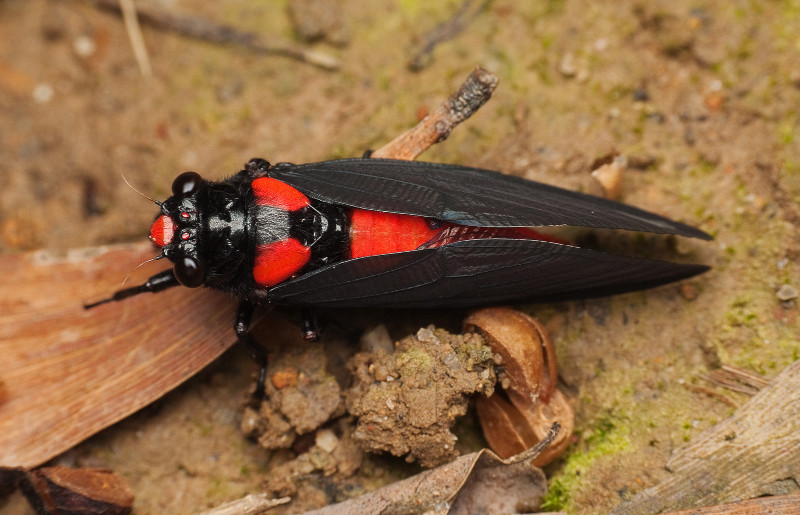
Black and scarlet Cicada Facts
- It’s immediately obvious to observer why the term Black and scarlet Cicada serves as the most frequently used common name for this insect. The marvel of Nature does have other general titles, though. These include such highly shortened tags as simply the scarlet cicada.
- Within the scientific community, however, it’s likely significantly better known by its technical appellation. Fortunately for the layperson, though, that’s a comparatively easy one to pronounce, in this case. That’s because it holds the official epithet Huechys sanguinea.
- The remarkable invertebrate received that designation due to the efforts of Charles De Geer. The noted Swedish-Dutch entomoligist recorded the first official acknowledgement of it as a separate and distinct species. He achieved that scientifically noteworthy deed in 1773.
- This marvel of Nature and evolution earns note among scientists as well as those who appreciate its sheer visual splendor, though. This respect occurs due to an impressive statistic. Entomologists currently recognize four subspecies of this highly intriguing Arthropod.
- Thankfully, the amazing Black and scarlet Cicada appears to still be maintaining a population base that’s both sufficient and stable. That pleasant state further seems to hold true throughout its known range. The invertebrate thus does not presently appear on the IUCN Red List.
- It nevertheless still faces potential threats to its continued existence as a species. In this respect, it shares the same dangers as most creatures on earth today. It’s presently faced with the dual related perils posed by habitat loss and the ongoing effects of climate change.
Related Articles
Black and scarlet Cicada Physical Description
The gorgeous Black and scarlet Cicada certainly grabs the attention of most people the moment they’re fortunate enough to encounter one. That typically occurs due to its admittedly striking appearance, however. That’s true since, in terms of size, it’s not an overly large variety of insect.
In this respect, it also follows a pattern of evolution shared by many species around the world. That’s the fact that the insect displays a certain degree of the physiological characteristic of sexual dimorphism. In this specific case, that presents itself with the females being larger.
Overall, however, the size difference between the genders remains compoaratively minor. Otherwise, the two sexes appear virtually indistinguishable. Variations also naturally occur between the four subspecies. Size varies between these, while color varies slightly between individuals.
Among the various forms of the creature, an average body length ranges from approximately 0.8 – 1.2 in (2 – 3 cm). Like that of a grasshopper, the shape of this tends to be elongated. It also tends to be quite robust in form, with well-developed legs designed for both perching and jumping.
Yet, it’s undeniably the coloring of the fabulous Black and scarlet Cicada that garners the most appreciation. The very name for the impressive insect, in fact, describes this as a general principle. But, despite the name, the overall pattern isn’t quite as simple as the title itself implies.
As previously stated, the coloration of the versions of this product of evolution can vary, but it commonly has a combination of hues such as green, brown, yellow, orange, black, and even a speckled patterning. Additionally, its wings also sometimes display translucent areas.
The large head of the natural wonder, meanwhile, typically features extremely prominent compound eyes and short antennae. Its thorax and abdomen also develop as relatively large, containing muscles necessary for producing the buzzing sound that cicadas are known for.
- Kingdom: Animalia
- Phylum: Arthropoda
- Class: Insecta
- Order: Hemiptera
- Family: Cicadidae
- Genus: Huechys
- Species: H. sanguinea
Black and scarlet Cicada Distribution, Habitat, and Ecology
In a fortuitous turn of events, the awesome Black and scarlet Cicada evolved as native to a comparatively broad swathe of the surface of the earth. Coming as no surprise to many, that native zone of habitation consists of much of what’s currently known as the continent of Asia.
There, though, the magnificent animal makes its home in the general south and southeastern portions of the region. That includes India and Myanmar, southern China, Taiwan, Thailand, Vietnam, the Malay Peninsula, Borneo, Singapore and even into Sumatra and Timor.
Much like its many relatives found around the globe, this creature displays rather impressive flexibility regarding its choice of habitat. Its thus seen in a moderately wide range of habitat types. The number of subspecies existing further augments this degree of variety, of course.
Within its territory, the intrepid invertebrate therefore resides in regions of both temperate and tropical climates. It frequently makes its home in areas of dense, lush forests. Yet, it also often appears within residential areas, such as parks and sometimes even inside private yards.
As nymphs, the Black and scarlet Cicada typically feeds on the sap of tree roots. Once it emerges, it primarily feeds on sap from trees using its piercing mouthparts. This feeding can occasionally causes damage to the host trees but is not usually considered harmful on a large scale.
Like many of its kind, it’s eaten by many predators, including birds, reptiles, mammals, and predatory insects such as mantises, spiders, and some wasps. Its bright coloring also serves as a clear warning to potential predators, though, indicating that it may be toxic or distasteful.
Species Sharing Its Range
Check out our other articles on Earth’s Amazingly Abundant Avians, Southern Elephant Seal, Mount Erebus, Southern Stingray, Bird’s nest Banksia, Weka, Tree Bumblebee, Orinoco Crocodile
